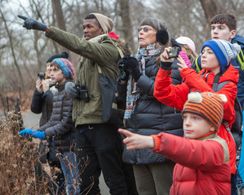

13 Jan, 2015 | by Labroots
Clams Go Disco and Light It Up.While not normally thought of as a club hopping creature capable of glowing in the dark and poisoning predators, the âdisco clamâ or Ctenoides ales as it is formally known, has been impressing researchers with its ability to light up the sea floor. A team of researchers from the University of California-Berkley presented their findings on January 4th at the 2015 annual conference of the Society...... Read More

12 Jan, 2015 | by Labroots
With Christmas Comes the Count.This year, from December 14 2014 to January 5, 2015, Christmas lights, Hanukah candles, holiday parties and New Yearâs celebrations will not be the only traditions observed. The National Audubon Society will hold its 115th annual Christmas Bird Count. Thought to be the largest citizen science endeavor, the CBC is comprised of over 30,000 volunteers worldwide. Researchers, conservation biologists...... Read More

05 Dec, 2014 | by Labroots
Israeli Virologist Working on Ebola Cure CallsâThe world has been asleep for 50 years regarding infectious diseases and Ebola is the wake-up call,â said Ben-Gurion University of the Negev (BGU) Professor Leslie Lobel, one of the few virologists worldwide who has been focused on Ebola, Marburg and other infectious diseases emanating from Africa. According to Dr. Lobel, âFifty years ago, we were dealing with eradicating polio, smallpox and...... Read More

04 Dec, 2014 | by Labroots
Study Identifies Possible Treatment Target for Cocaine AddictionA study led by investigators from Massachusetts General Hospital and the Perelman School of Medicine at the University of Pennsylvania has identified a possible target for therapies that can treat cocaine addiction. Â The study, which received advance online publication in Molecular Psychiatry, found evidence that changing one amino acid in a subunit of an important receptor protein can change the...... Read More

03 Dec, 2014 | by Labroots
Babies, rabies and the nervous systemAbout 55,000 people die from rabies every year. The dreaded disease causes acute inflammation of the brain, producing psychosis and violent aggression.  The virus, which paralyzes the bodyâs internal organs, is always deadly for those unable to obtain vaccines in time. Tel Aviv University scientists have discovered the exact mechanism this killer virus uses to efficiently enter the central nervous...... Read More

02 Dec, 2014 | by Labroots
BGN Technologies, EMC and Jerusalem Venture Partners Form New CyberSpark Industry Initiative, a Nonprofit CompanyBGN Technologies, the technology transfer company of Ben-Gurion University of the Negev (BGU), EMC Corporation and Jerusalem Venture Partners recently announced the CyberSpark Industry Initiative, which will serve as a coordinating body for joint cyber industry activities with government agencies, the Israel Defense Force (IDF) and academia. The innovative public/private cyber center established in...... Read More

01 Dec, 2014 | by Labroots
Making Rare Disease Drug Research Pay OffWith drug companies investing huge amounts of time and money to produce viable products, it is not surprising that they look for drug candidates that will provide a return on the investment. Whereas rare diseases may not have been the way to go before, there are indications that the trend may be changing in some sectors. A case for developing drugs for rare, orphan diseases can be found in the most...... Read More

28 Nov, 2014 | by Labroots
Hopping And Hoping...After multiple months of waiting for final permits, the Oakland Zoo has acquired the necessary state and federal permits to help save the Mountain Yellow-Legged frog, a highly endangered amphibian. This frog species, which once hopped throughout California’s upper elevations, has dropped significantly in numbers, more than ninety percent in the past decade, due in part to chytrid, a skin fungus that...... Read More

27 Nov, 2014 | by Labroots
The Secret Life of the Sea TroutWhile not normally thought of as a dodgy character, the sea trout, a distant cousin of the Norwegian Salmon has a lot of secrets. Researcher Jan G. Davidson and his graduate students are on the case and trying to decipher the development and habits of the sea trout and in the process hopefully discover why there has been a 60% reduction in the numbers of sea trout in Norway. Similar to their salmon...... Read More

26 Nov, 2014 | by Labroots
How Can You Mend A Broken Heart? Activate the molecular machineryResearchers at the Salk Institute, La Jolla, Calif, have repaired injured hearts in mice by reviving long-inactive molecular machinery in the animalsâ cells, which may lead to new therapies for human heart ailments. The mice exhibited dramatic improvement in heart regeneration and healing after the researchers blocked four molecules believed to suppress these programs for regenerating organs. The...... Read More